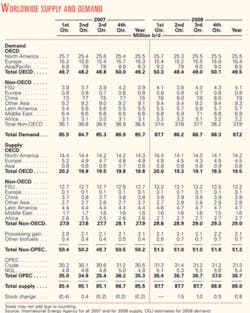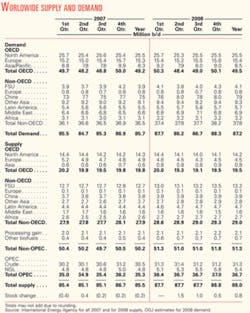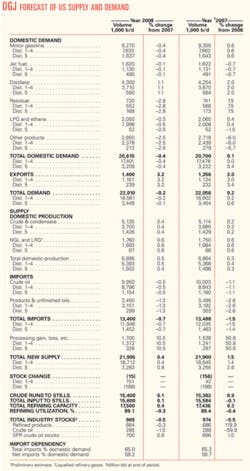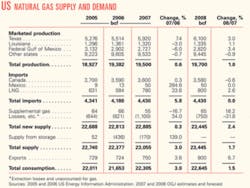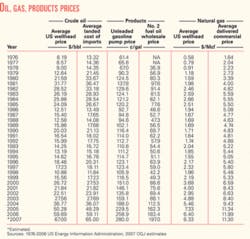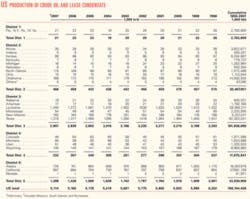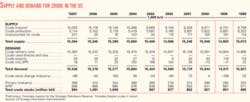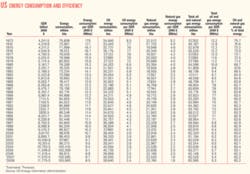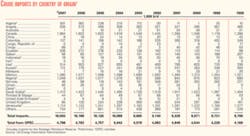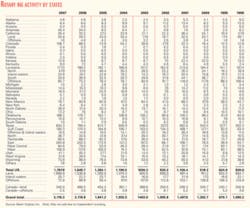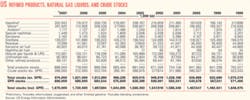SPECIAL REPORT: Energy demand to grow slowly worldwide, stagnate in the US
US energy demand in 2008 will be nearly unchanged from last year. Weakness in the US economy, in addition to a global economic slowdown, will hold growth in check.
Demand for natural gas will grow modestly in the US, and there will be a small uptick in the use of renewable energy this year. But the use of all other forms of energy will decline or hold steady from 2007.
Oil prices will moderate this year, but conservation will come into play as consumer spending power weakens as the economy slows. Demand for most oil products in the US will decline.
Last year’s high oil prices were attributed to a host of factors, including the weak US dollar, limited spare production capacity, geopolitical tensions, and rising demand in China, India, and other developing economies.
Global oil demand
OGJ forecasts that a weakening global economy will hold worldwide oil demand growth to 1.8% this year, with consumption averaging 87.2 million b/d. Most demand growth will occur outside the Organization for Economic Cooperation & Development.
North American oil demand will be unchanged from the International Energy Agency’s 2007 demand estimate of 25.5 million b/d. Meanwhile, demand growth in the European member countries of the OECD will inch up 0.8% to 15.4 million b/d for the year.
Weakening after averaging 9.2 million b/d in the first quarter of 2008, average OECD Asia-Pacific demand will climb to 8.5 million b/d from 8.3 million b/d last year.
Outside the OECD, demand will increase 3.5% this year, averaging 37.8 million b/d. China and the former Soviet Union will lead this year’s growth, each with annual gains of about 5%. But demand growth in China will wane following this year’s Olympic Games.
Most other regions also will post demand gains from 2007, but non-OECD Europe demand will be unchanged at 800,000 b/d.
Worldwide oil supply
Crude supply this year will climb nearly 3%, allowing stocks to build.
Gains in natural gas liquids production will combine with a small increase in crude output from members of the Organization of Petroleum Exporting Countries, as well as rising production in the former Soviet Union, China, and Brazil this year. Supply and demand estimates for Ecuador, which rejoined OPEC at the start of 2008, are still included in non-OPEC figures in this report.
Total oil supply this year will average 88 million b/d. Supply from the OECD countries will decline 1.5% this year to average 19.5 million b/d. Australia will record production growth this year, but supply from North America and Europe will fall.
Combined oil output from the former Soviet Union will average 13.2 million b/d, according to IEA. Last year these countries’ production averaged 12.7 million b/d.
The Paris-based agency also estimates that processing gains will hold at 2.1 million b/d this year but that supply of biofuels and fuel ethanol from outside the US and Brazil will increase to 700,000 b/d from 400,000 b/d last year. This puts the forecast for all non-OPEC supply at 51.3 million b/d for 2008, up 2.2%.
For the fourth quarter of 2007, OGJ estimates that OPEC production was 31.2 million b/d, making the organization’s crude output average 30.5 million b/d for the year.
With weakening worldwide demand, slightly lower oil prices, and increases elsewhere, OPEC output will be little changed over 2008. OGJ expects OPEC crude production to average 31.3 million b/d this year. Combined with the 5.4 million b/d of NGL that IEA expects from OPEC, stocks will build 800,000 b/d.
US economy, energy
With help from the Federal Reserve in the form of lower interest rates, the US will narrowly avoid slipping into a recession for the year. Growth in 2008 will be shallow to nil in the first half, but a small upturn will materialize in the third and fourth quarters.
OGJ forecasts that US gross domestic product will grow a meager 1.8% this year, compared with 2.2% growth for 2007.
Employment weakness appeared in August of last yearthe first monthly decline in the employment rate in 4 yearsand 2007 was the weakest year for job growth over the same period. Drops in construction and manufacturing payrolls revealed that the housing crunch hurt the economy.
Workers’ earnings gained slightly at the end of last year, but inflation for the first 11 months of the year was 4.2%, according to the Bureau of Labor Statistics. This compares with inflation of 2.5% for all of 2006.
The consumer price index for energy, which increased 2.9% in 2006, advanced at an 18.1% seasonally adjusted annual rate in the first 11 months of 2007. Petroleum-based energy costs increased at a 30.8% annual rate, and charges for energy services rose at a 3.2% annual rate, BLS reported.
The economic slowdown and conservation will keep energy demand growth negligibleto 101.005 quadrillion btu (quads) from 100.91 quads last year.
Energy by source
Consumption of oil and coal will decline slightly this year in the US while the use of natural gas and renewable energy grows slightly.
Natural gas demand will climb to 23.19 quads, bringing the gas energy market share to 23%, higher than coal’s 22.5%.
Coal demand this year will decline by 0.5% following a 2% power generation-led gain during 2007. The use of nuclear energy will be unchanged at 8.3 quads. Last year’s increase in energy demand drove the use of nuclear energy in the US up 1% to its highest annual level.
Demand for alternative energy sources, including hydroelectric power generation, solar, and wind energy, will climb only 0.6% this year, following a 2% decline last year. These renewable energy sources account for just below 7% of the US energy market.
Oil demand this year will be down 0.4% from 2007, totaling 39.84 quads. Last year’s use of oil products was up negligibly to 40 quads. Strong prices have encouraged efficiency in the use of jet fuel and motor gasoline. And the use of oil products as petrochemical feedstocks has been on a downward trend in the US.
Combined, oil and natural gas will comprise 62.4% of the US energy market this year, up slightly from a year ago.
Oil supply
The 2007 and 2008 start-ups of some major upstream projects will help boost US crude and condensate production to an average 5.135 million b/d this year.
This year’s expected start-ups include Thunder Hawk, Thunder Horse, and Tahiti in the Gulf of Mexico (OGJ, July 23, 2007, p. 43). These big oil-producing fields join Atlantis and Neptune, which are already on stream. Combined, the five fields’ peak production will exceed 1 million b/d.
Oil production increased slightly last year to 5.114 million b/d, according to OGJ estimates, from 5.102 million b/d in 2006.
During 2007, a large gain in production in Louisiana mostly offset declines in a handful of other states. Oklahoma, Texas, Colorado, and California incurred dips in production last year, while Louisiana production averaged 1.34 million b/d, up more than 5% from a year earlier.
Alaskan oil production declined last year to average 720,000 b/d, down from 741,000 b/d in 2006 and 864,000 b/d in 2005. Crude and condensate production in Alaska hasn’t increased since 2002, when average output climbed to 988,000 b/d from 963,000 b/d in 2001.
OGJ forecasts that average NGL production this year will rise to 1.76 million b/d from 1.75 million b/d last year and 1.739 million b/d a year earlier.
Inventories
Stocks of crude and products finished 2007 lower than a year earlier. Crude inventories closed out the year down more than 8% to a level able to meet refinery needs for 19 days. At yearend 2006, crude supplies stood at more than 20 days of refinery inputs.
Total motor gasoline inventories were down slightly at the end of 2007, and jet fuel stocks were up marginally. Inventories of residual fuel oil and other oil products finished last year lower.
But distillate stocks, especially high-sulfur distillate inventories, were much lower from a year earlier. High-sulfur (more than 500 ppm) distillate, ended last year down 36%, while ultralow-sulfur distillate stocks climbed 17% from a year earlier.
The amount of crude oil in the Strategic Petroleum Reserve climbed slowly throughout the year and stood at 696 million bbl at the end of 2007. OGJ expects the SPR to end 2008 at 700 million bbl.
Refining
Refining activity will decline slightly again this year, after the average utilization rate for 2007 decreased to 89.4% from 89.7% a year earlier.
Capacity utilization hovered just below 90% throughout much of 2007 because of maintenance and temporary shutdowns. Last year was a busy year for maintenance and turnarounds because refiners had delayed such work for about 2 years to take advantage of high margins.
US refiners’ acquisition costs for crude rose sharply last year, especially costs for imported crude. Refiners paid about 12% more for domestic crude during 2007, as the average cost was an estimated $69.80/bbl. But for imported crude, the average cost was up almost 15% from a year earlier, averaging about $67.50/bbl last year.
Refining margins were mixed last year compared to those of 2006. In the US, cash margins for refiners in the Midwest, nearest to most ethanol plants, were especially strong, up 27% to average $19.30/bbl for all of last year, according to Muse, Stancil & Co. The May 2007 average was the year’s peak at $34.25/bbl, more that twice the average of May 2006.
Cash margins grew at more modest paces during 2007 for East Coast refiners, up 11%, and for Gulf Coast refiners, up 4% from the prior year. US West Coast refiners posted a 10% lower average margin last year.
Oil imports
The US will import reduced volumes of crude and products this year. OGJ forecasts that after last year’s 1.5% decline in total gross imports, crude imports will decline 0.5% to 9.95 million b/d this year. Product imports will fall 1.3%, averaging 3.45 million b/d.
Strong demand for oil products drove imports higher on the US West Coast last year, as EIA figures for imports into Petroleum Administration for Defense District 5 show.
While total US demand for oil products last year declined 0.6%, demand in PADD 5 for all petroleum products climbed 1.5%. Distillate and residual fuel oil were especially strong in comparison to demand in the other four PAD districts.
Canada was the US source not only of the most imported crude during 2007 but also of the highest volume of product imports for the year.
Oil demand
Demand for oil products for the entire US this year will decline to an average 20.61 million b/d in 2008 from 20.7 million b/d a year ago. In 2006, US demand for petroleum products averaged 20.688 million b/d.
Weak economic conditions coupled with relatively strong fuel prices will encourage conservation. Motorists will use less gasoline, and airlines have been flying fewer but fuller flights.
Demand for all products except distillate will fall from last year’s levels.
Distillate
The increase in distillate consumption will reflect strength of the diesel market. Consumption of home heating oil, the other main distillate product, will be suppressed by above-normal temperatures predicted by the National Weather Service for most of the US.
Diesel’s strength will raise average demand for all distillate to 4.3 million b/d this year from 4.25 million b/d last year and 4.169 million b/d in 2006.
Much of diesel’s consumption growth reflects increasing production of ethanol for blending with gasoline. Ethanol and its main feedstock, corn, move to processing and blending facilities by rail or truck.
Production of fuel ethanol climbed to an average 452,000 b/d in October 2007, the latest month for which such data is available from EIA. This brought the 2007 year-to-date average to 411,000 b/d.
In December Congress passed an energy bill that raises the renewable fuel standard to 36 billion gal by 2022, more than half of which must come from sources other than corn (OGJ, Dec. 24, 2007, p. 30). The current standard, set in 2005, peaks at 7.5 billion gal/year in 2012.
The new measure will further boost consumption of distillate because of ethanol’s transport requirements. More than two thirds of current distillate demand is ultralow-sulfur diesel required for on-highway use.
Motor gasoline
Following 15 years of growth, demand for motor gasoline will decline this year. Higher prices are changing driving habits.
Average gasoline demand will be 9.27 million b/d, compared with 9.3 million b/d last year and 9.25 million b/d in 2006.
Regular unleaded pump prices in 2007 increased 7% from a year earlier, according to BLS figures. In 2006, the pump price for regular unleaded fuel rose 13% from a year earlier.
Following springtime maintenance, inventories of gasoline will be pinched. Gasoline prices will rise at the start of this year’s driving season as summer blends return to the market.
Jet fuel
Demand for jet fuel this year will be nearly unchanged at 1.62 million b/d. Airlines have improved efficiencies over the past few years such that in 2007 jet fuel consumption dipped 0.7% from 1.633 million b/d a year earlier.
Retail prices for jet fuel were slightly lower or unchanged for the first 8 months of last year, but in September and October jet fuel prices climbed 13% and 30% respectively from year-earlier levels. Inventories were adequate; the price hike was due to rising crude costs.
Residual fuel oil
Resid demand will fall almost 3% to 720,000 b/d after last year’s price-driven 7.5% increase.
High natural gas prices during 2007 gave resid consumption a boost. Although switching capacity between gas and resid for electric generation is on the decline, there is still enough to make an impact.
Resid prices over the past 2 years were strong, too. Through the first 9 months of 2007, the average end-user price of resid was $1.28/gal, up from $1.26/gal a year earlier and an average of 99¢/gal in the first 9 months of 2005.
LPG, other products
Demand for liquefied petroleum gases will decline to 2.05 million b/d, about the same as demand for these products in 2006.
Last year LPG consumption averaged 2.06 million b/d as US demand for propane and propylene climbed. Exports of propane and propylene last year declined about 15%, but production of these products at refineries increased.
Average demand for all other petroleum products this year will decline to 2.65 million b/d from 2.72 million b/d last year and 2.89 million b/d in 2006.
This group of products includes pentanes-plus, unfinished oils, gasoline blending components, and other hydrocarbons and oxygenates. Demand for these products used in construction will be hurt by this year’s economic sluggishness.
Natural gas
Growth in electric power generation will drive US demand for natural gas this year.
Gas demand will total 22.195 tcf, up 1.5%. Last year, gas demand climbed 3%.
Marketed production of gas in the US will grow to 19.7 tcf up from 19.5 tcf last year. Production in Texas, Louisiana, and the federal Gulf of Mexico will post increases. Last year, production declined in Louisiana and in federal waters of the gulf.
Major upstream projects coming on stream in 2007 and 2008 will boost production this year. These big gas producers include Independence Hub, Atlantis, Phoenix, Thunder Hawk, and Thunder Horse.
Total gross imports will be unchanged this year at 4.43 tcf. Last year, a surge in LNG imports resulted in a nearly 6% increase in gas imports, but LNG imports this year will grow more modestly.
OGJ forecasts that LNG imports will be 800 bcf this year. Imports from Mexico will remain at 50 bcf, and imports from Canada will decline to 3.58 tcf from 3.6 tcf last year.
The source of the largest volume of last year’s LNG imports was by far Trinidad and Tobago. Egypt, Nigeria, and Algeria were also major sources for last year’s imports.
US gas exports will climb almost 7% this year. Last year, exports rose to 750 bcf from 724 bcf a year earlier, as pipeline exports to Canada increased but exports to Mexico declined a little.
Residential demand and demand for natural gas by electric power producers drove last year’s increase in consumption. Deliveries of gas to commercial and industrial users last year grew, as well. Production and imports were up, and inventories were plentiful throughout 2007.
The amount of working gas in storage has weakened prices. Since early 2006, inventories have been at or near the top of the 5-year range of working gas in storage.
Since then, gas prices have dropped. Gas futures prices on the New York Mercantile Exchange peaked in December 2005 with a closing price as high as $15.378/MMbtu.
Inventories closed 2007 near the middle of the 5-year range at about 2.75 tcf. This was down 9% from yearend 2006.
During 2007, prices were largely range-bound, with the lowest futures closing price occurring on Aug. 27, 2007, at $5.38/MMbtu. The peak closing price for the year registered on Nov. 1, 2007, at $8.637/MMbtu.
